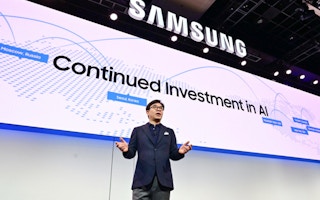Samsung Electronics, one of Asia’s most powerful corporations, has committed to use only renewable energy by 2050, but has warned that its ability to source clean energy in its home market is “limited”.
To continue reading, subscribe to Eco‑Business.
There's something for everyone. We offer a range of subscription plans.
- Access our stories and receive our Insights Weekly newsletter with the free EB Member plan.
- Unlock unlimited access to our content and archive with EB Circle.
- Publish your content with EB Premium.
The clean energy-only declaration is part of the Korean giant’s plan to reduce its direct and indirect emissions to net-zero by 2050, as detailed in a corporate statement released on Thursday.
In the statement, Samsung Electronics chief executive Jong-Hee Han said the consequences of climate inaction were “unimaginable” and detailed a plan to reduce emissions and ramp up technologies to fight climate change.
The company aims to cut out fossil fuels entirely from its electricity supply by 2027 in Southeast Asia and Africa, by 2025 in Central and Latin America and by the end of 2022 in Southwest Asia and Vietnam.
Samsung is already fully renewables-powered in the United States, China and Europe, where clean energy is relatively easy to procure.
The company did not give a date for fossil fuels phase-out in South Korea, Samsung’s home market and major manufacturing hub, where it consumes 74 per cent of its worldwide energy use.
Samsung noted that RE100, a club of firms committed to renewables, cites South Korea as “one of the most challenging countries” for the sourcing of renewable energy.
“This is in part due to the country’s renewable energy market, where procurement options for corporations have begun to expand but remain limited,” Samsung said in a statement.
Realistic target?
Samsung’s climate pledge was met with caution from environmental groups, who pointed out that the company’s pledge comes soon after the South Korean government lowered its 2030 renewable energy target from 30.2 per cent to 21.5 per cent of the energy mix.
The country, which in 2020 committed to be carbon neutral by 2050, is moving towards nuclear as its preferred low-carbon energy source as its gradually reduces its use of coal, the biggest source of man-made greenhouse gas emissions.
South Korea has one of the lowest shares of renewables among member nations of the G20, a group of wealthy countries. The East Asian nation produces less than 5 per cent of its electricity from solar and wind, compared to a 10 per cent global average.
Samsung’s decision sends a “strong signal” for a faster renewable energy transition in its home country, said Seoul-based non-government organisation Solutions for Our Climate (SOC).
Renewable energy procurement in Korea is complicated by the country’s power market structure and regulations that limit renewable generators from entering the market and the grid, noted SOC.
It can take more than seven years to get approval for an offshore wind project in Korea, while onshore wind developers must go through eight ministries and secure 22 permits, the NGO pointed out.
“Samsung’s commitment demonstrates the growing importance of corporate renewable buyers to accelerate the global energy transition,” said Janghyeok Lim, a power market researcher at SOC.
As part of its climate plan, Samsung said it was developing carbon capture technology and air filtration technologies.
Samsung was among a handful of companies to commit to avoid using deep-sea mined minerals in its supply chain last year. Deep-sea mining for minerals used in electronics products and also renewable energy technologies such as electric car batteries and solar panels, is set to go ahead on an industrial scale by next year.










